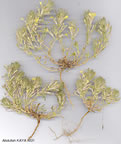| Lamiaceae |
| Ajuga L. Ajuga chamaepitys (L.) SCHREBER subsp. cuneatifolia (STAPF) P. H. DAVIS Ömür: Çok, İki veya Tek yıllık Yapı: ot Hayat formu: İlk çiçeklenme zamanı: 6 Son çiçeklenme zamanı: 8 Habitat: kayalık kalkerli yamaçlar ve kayalık uçurumlar Minimum yükseklik: 1000 Maksimum yükseklik: 3660 Endemik: - Element: ? Türkiye dağılımı: B., G. ve GD. Anadolu Genel dağılımı: K. Irak Bulunduğu kareler:A1 A2 A3 A4 A5 A6 A7 A8 A9 B1 B2 B3 B4 B5 B6 B7 B8 B9 B10 C1 C2 C3 C4 C5 C6 C7 C8 C9 C10 |
| A. chamaepitys (L.) Schreber, PL Vert. Unilab. 24 (1773). Davis in Notes R.B.G. Edinb. 38:24-32 (1980, with illustrations of cauline and floral leaves of all subspecies). Syn: Teucrium chamaepitys L., Sp. PL 562 (1753). Perennial, biennial or annual herbs, very variable. Stems prostrate or ascending, variously hairy or glabrous. Cauline leaves cuneate to cuneate-oblong, shortly 3-lobed to deeply 3(-5)-partite, hirsute, villous, lanate or sub-glabrous; floral leaves usually somewhat more deeply divided. Verticillasters 2-flowered. Calyx 4-6 mm, teeth 0.5-l(-2) x tube. Corolla yellow (sometimes drying pinkish), 8-30 mm, upper lip short and emarginate, middle lobe of lower lip bilobed. Stamens exserted beyond reduced upper lip. Nutlets 2.5-4 mm, transversely rugulose, often foveolate towards apex. Calcicole. 1. Stems glabrous, usually purple; cauline leaves broadly oblong and often sheathing below the linear lobes; inflorescence usually a terminal panicle; corolla (18-)20-25 mm b. subsp. laevigata 1. Stems hairy all round or at least on 2 opposite sides, usually green; cauline leaves not broadened out and ± sheathing below the lobes; inflorescence usually simple ; corolla 8-30 mm 2. Dwarf alpine plants (usually on scree) with subterranean caudiculi and short, densely leafy shoots;lower floral leaves obtusely lobed to 1/3-1/2, shortly villous;corolla 18-22 mm d. subsp. glareosa 2. Plants not as above 3. Middle lobe of lower floral leaves linear, 6-many times longer than broad, as long as or longer than attenuate basal portion; stems spread-ing-hirsute, or shortly hairy only on 2 opposite sides ;corolla 16-23 mm a. subsp. chia 4. Stems hirsute with long stiff patent hairs on all sides var. chia 4. Stems glabrous on 2 opposite sides, retrorse-puberulent on the other two sides var. ciliata 3. Middle lobe of lower floral leaves broadly ovate to linear-oblong, less than 6 x longer than broad, shorter than to as long as narrowed basal portion; stems usually woolly or sometimes pubescent-canescent all round; corolla 8-25(-30) mm 5. Lower floral leaves divided to halfway into linear-oblong lobes; corolla 15-20 mm 6. Prostrate plant of stony slopes or disturbed ground; flowering stems sparsely to densely villous, usually branched; basal leaves (when present) linear-oblanceolate, remotely crenate-dentate c. subsp. palaestina 6. Plant of rock crevices; flowering stems lanate-villous, ± simple ;basal leaves (when present) narrowly obovate, subentire to crenate e. subsp. euphratica 5. Lower floral leaves divided to less than halfway; corolla 8-25(-30) mm 7. Corolla 8-11 mm, usually drying pinkish; lower floral leaves only 8-14 mm, usually divided to 1/4 or less into short rounded to ovate-oblong lobes h. subsp. cypria 7. Corolla 12-25(-30) mm, remaining yellow on drying; lower floral leaves 5-27 mm, divided to 1/3 to nearly halfway 8. Inflorescence columnar, the densely imbricated floral leaves having acute oblong-lanceolate lobes;corolla 12-14 mm j. subsp. rechingeri 8. Inflorescence not as above; leaf lobes obtuse; corolla 14-25(-30) mm 9. Cauline and lower floral leaves 5-12 mm, cuneate-oblong, 3-fid to 1/4-1/2; plant canescent with short slender dense subadpressed hairs;corolla 14-20(-24) mm i. subsp. mardinensis 9. Cauline and lower floral leaves 10-27 mm, cuneate to obtriang-ular, 3(-5)-fid to 1/3; plant lanate or patent-pilose, more robust; corolla 15-25 mm 10. Stems ± densely lanate; floral leaves lanate and greyish, cuneate or oblong-cuneate, divided into ovate to oblong lobes f. subsp. mesogitana 10. Stems patent-pilose, with many subsessile glands visible; floral leaves pilose, greenish, conspicuously glandular, broadly cuneate to obtriangular, divided into broader lobes g. subsp. cuneatifolia g. subsp. cuneatifolia (Stapf) P.H. Davis in Notes R.B.G. Edinb. 38:30 (1980). Syn: A, chia (L.) Schreber var. suffrutescens Boiss., Fl. Or. 4:803 (1879) p.p. quoad speciminibus Tauri Isaurici! A. cuneatifolia Stapf in Denkschr. Akad. Wiss. Wien. Math.-Nat. Kl. 50(1) :102 (1885)! Fl. 6-8. Rocky limestone slopes and rocky crevices, c. 1000-3660 m. Type: [Turkey C2 Antalya/Muğla] Lycia, Akdagh, 17 vii 1882, Luschan (holo. WU!). Scattered in W., S. & S.E. Anatolia. Bl Balikesir: mt. Ida (Kaz Da.) nr Kareikos, Sint. 1883:788a! C3 Antalya: Bozburun Da. above Çukur Y., 1900-2100 m, D. 15622! C4 Antalya: Geyik Da., 2440 m, Da. 14500! C5 Niğde: Ala Da., 2300-3200 m, 3 viii 1962, Urdl! C9 Hakkari: Cilo Da., in Diz De., 1760 m, D. 23880! C10 Hakkari: W. of Cilo Tepe, 3660 m, D. 24198 (dwarf alpine form, stems sparsely pilose)! N. Iraq. |
